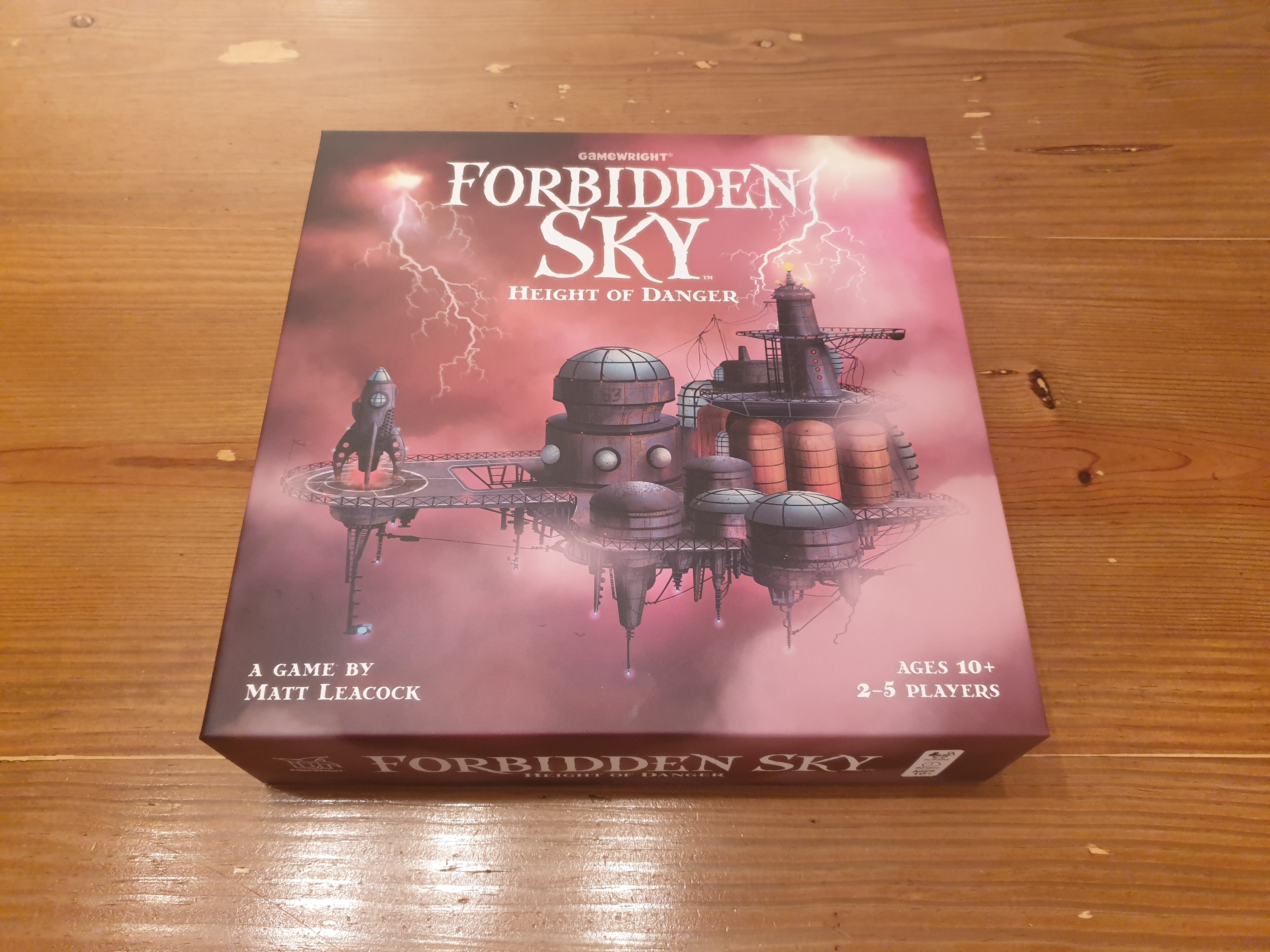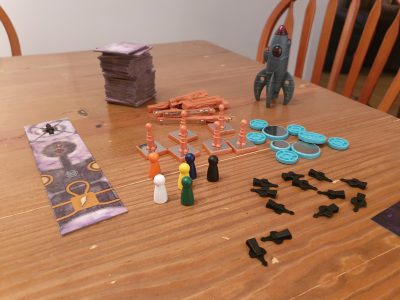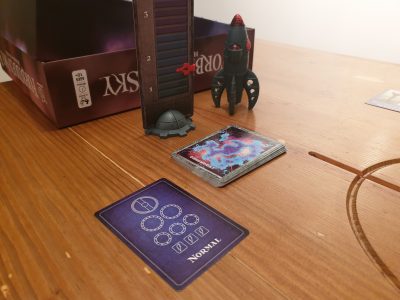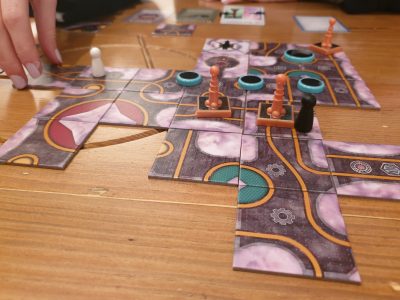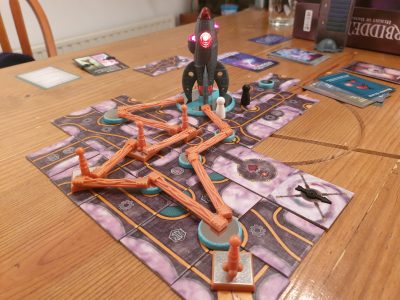Forbidden Sky is the third instalment in the Forbidden series of cooperative board games, from famed designer Matt Leacock – the man behind the Pandemic series. Published by Gamewright, featuring artwork by C. B. Canga, the game sees 2 – 5 players stuck on a floating platform amidst an electrifying and blustery storm. So you’ve escaped a flooding island and flown out of a desert, but how do the skies hold up against them? Let’s find out!
Setting up the game is simple. A larger starting tile is placed in the middle of the table, with circuit components (including the plastic rocket) placed within reach. The role cards are shuffled with each player taking one before returning the rest to the box. The power platform tiles are shuffled, with one being dealt to each player and the rest stacked within reach. The storm meter is stood up within sight, with the equipment and Storm deck placed next to it. The only choice for players is to select a difficulty setting, ranging from Novice to Legendary.
The difficulty setting card reveals the minimum components that players must make a circuit around, touching both sides of a special rocket ship launch pad. At the start of the game only a single lightning rod will stand on the board but before long other components will appear. On a turn players will take up to four actions, before drawing an amount of storm cards – based upon the current storm intensity.
The four actions available to players are move, scout, explore and wire. Move, as the name suggests, allows the player to move their player pawn to an adjacent (non-diagonal) tile. There is a limitation to this, that there is platform not sky connecting the tiles. Some tiles also feature a teleporter pad, with all teleport pads treated as adjacent for the purpose of movement. The next action, Scout, is only available if the player has fewer than 3 tiles in front of them, seeing the player draw the top platform tile from the draw pile.
Explore is the action that allows players to place one of their scouted tiles into an empty adjacent space, from the tile they are positioned on. When placing new tiles one wire must continue from the current board, not both if two are shown. When placed, if the two connected tiles complete a small yellow loop a small capacitor is placed and if via corners a medium green loop is complete a large capacitor is placed. If a tile has a square with a lightning bolt symbol a lightning rod is instantly placed onto the tile.
If a completed large red loop is created across 4 tiles then the rocket ship launch pad is put into play. The final placement if is, if a tile features a gear symbol the player draws the top gear card. It might read like a lot of ifs but when playing these are very logical consequences. The last action is to wire, seeing the player add a wire piece between a component touching their tile to another. Players can take any of the four actions as many times as they wish and in any order – as they spend their four action points.
Once action points are spent the board fights back. There are four types of cards in the storm deck; high wind, wind direction, storm intensify and lightning strikes. High winds see players blown one tile in the direction of the wind dial, unless they are stood on a tile with a wind shelter. This can blow players off the platform, including when the adjacent tile is joined via sky. Falling off causes the player to reduce their rope tracker by 1, instead of moving. Do this too many times and your rope breaks, causing the game to be over. Wind direction changes come up now and again, moving the wind direction dial either clockwise or counter-clockwise.
Storm intensifies cards increase the storm meter by one stage, with increases potentially increasing the number of storm cards drawn each round. Reach the top of this time like tracker and it is game over, though it is hard to reach this without failing in a different way. Lightning strikes cause players stood on tiles either with a lightning rod or connected to one by wires to be jolted. This sees the players health meter decease one step, unless the are on a tile with a Faraday cage, though thankfully damage taken is limited to once per lightning strike. Like with the rope breaks, lose too much health and it is game over.
Each character has unique rope and health stats to manage, however if one team member is out the game is lost for all. To win the game players must first scout and explorer enough to find the launch pad and then wire the platform, through the components denoted on the difficulty card. Before the final wire is placed, which triggers the end of the game, each player must be stood on one of the four tiles hosting the launch pad – no one wants to be left behind. Win or lose it is done as a team, no matter how close you are to finishing.
If it wasn’t for the gear along the way the game would be a factor harder. The effects might not sound huge, such as a free wire placement or a jetpack that allows a 1 tile movement, but these little extras add up. None of these are actions so can be used on top of standard actions, allow players to do that little bit more before the storm card stage. If it wasn’t for a health kit being found in one run through the game would have been lost on the next turn, so getting gear can be awesome!
It isn’t the best when reading the rules for the first time you come across something that already hints at a house rule being needed. Randomly drawing character cards during setup does somewhat guarantee a different experience in every game. Yet, it only compounds the issue that some characters seem stronger than others. Having a Medic or Knotsmith to be able to occasionally bump up what are effectively the two health bars players have can be invaluable: mostly so other players don’t have to spend half their action points attempting to be safe from the storm.
Forbidden Sky’s board expands across the table but it isn’t in a pretty way. The one wire must continue rule allows the game to work but creates a horrible looking non-flowing board. Sections of the platform can look like a thrown together scrapheap. The power platform shouldn’t look like a floating platform that could from the sky on a calm day – it is supposed to be a consistently pink storm that is bringing the terror. The wiring on the tiles remind me heavily of Tsuro, a game about following paths, but unlike that abstract title the wires are supposed to be part of the platform. Alas, they look like orange garden hoses plonked on top of a metal platform. It is more of a shame as the box art has set the game up for a fall, giving artistic promise before the lackluster tiles hit the table.
Skip the next two paragraphs if you do not want to go into the game with any pre-explained advise or part of the puzzle tainted.
Whilst players have the ability to build wires from the beginning of the game, leaving this until the end is clearly beneficial. Less wiring results in less danger when the lightning rains down on the platform. Once you’ve figured this out, which isn’t too far into game one, you’ll suddenly realise you have options to do on a turn. This is only added to the constant attempt to churn through the platform draw pile until the launch pad red pieces are found. It does make for an entertaining final few rounds, with players running around wiring everything up. However, suggesting players have four equal options for actions throughout becomes less true.
One incredible gaming experience came out of me not fully describing the components during setup to one group of players. When the circuit is fully complete the plastic ship not only lights up it also makes noise. As players weren’t anticipating this there was a wave of excitement that rippled around the table. Alas, whilst the first occurance of the ship being fully circuited creates a surprising child-like joy this gimmick does wear off. Also, the batteries will eventually go but, however damning it may be, I’ll have stopped playing long before they need to be changed.
Forbidden Sky revolves around the circuitry and the rocket. While a bold move to stand out from the crowd by using circuitry, something to be commended, it comes across as gimmicky. Unfortunately, the gimmick wears off relatively fast and some rules issues start to shine through. Without completely ruling the game out, it is good enough to suggest playing it once or twice – just not great enough to be something to shout about. For all the quirks of Forbidden Sky, it’s predecessor (Forbidden Desert) is a more rounded and recommendable experience.
[Editor’s Note: Forbidden Sky was provided to us by Coiledspring Games for the review. The game is priced at £39.99 on the official product page.]

